CROATIA
Dubrovnik

Dubrovnik
Dubrovnik
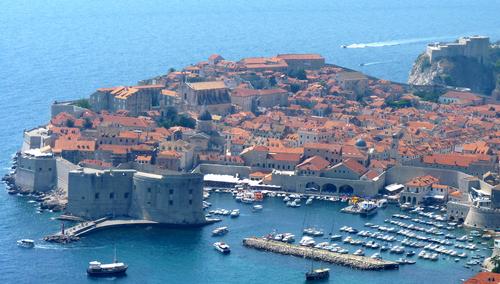 Dubrovnik PanoramaPhoto:Gari.baldi CC 2.0 Generic no changes made
Dubrovnik PanoramaPhoto:Gari.baldi CC 2.0 Generic no changes made
Dubrovnik is known as the Pearl of the Adriatic. The fascinating city is a tourist's dream, with the spectacular old town full of architecture, fortresses, museums and palaces. They are all monuments to the wealth of the city. Still protected by the ancient city walls, Old Dubrovnik is a real destination for history buffs.
Dubrovnik has a thriving port and has been declared a UNESCO World Heritage Site in its entirety. The city walls of the old town contribute to its medieval character. They are of great proportions and date from the 13th century. The coastline around Dubrovnik consists of a diverse mix of Adriatic beaches, there are a number of sandy beaches, other beaches consist of pebbles and small rocks.
| advertisement |
| Hotels Dubrovnik |
Location
Dubrovnik's old town and harbor are located on a peninsula on the Adriatic coast, in the southernmost region of Croatia, near Bosnia-Herzegovina and Montenegro. Dubrovnik is located at the foot of the limestone mountain Srd (412 m), in a valley enclosed by the Lapad plateau and a smaller reef with the oldest part of Dubrovnik.
Weather
The climate in and around Dubrovnik is Mediterranean, with mild, wet winters and warm summer weather, but it is a bit atypical due to the wind and the frequent thunderstorms. Between October and April, the Bura blows along the coastline, so the weather can be a bit erratic. The climate in spring and autumn is truly beautiful, with daytime temperatures ranging from 20 °C to 28 °C. July and August have maximum temperatures of around 29 °C, but occasionally the daytime temperature rises to 35 °C. The quietest time is during the winter months when there are few tourists and the area is quiet and serene. Warm clothing is a good idea, but the temperature never drops below freezing, but the Bura wind is most persistent. Precipitation mainly spreads in the cooler months, with the exception of summer thunderstorms.
History
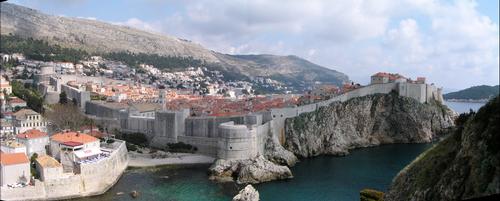 Dubrovnik City wallsPhoto: Public Domain
Dubrovnik City wallsPhoto: Public Domain
Dubrovnik is one of the most important cities on the Adriatic. Since its founding in the 7th century AD, Dubrovnik's history has been inseparable from the sea. During its heyday, Dubrovnik was one of the most powerful maritime republics, but today the harbor is more scenic than strategic.
The Adriatic Sea has always played an important role in the history of Dubrovnik, originally known as Ragusa. Greek refugees from Epidaurus took refuge here in the 7th century AD, fleeing invasions from the barbarians. They built walls to protect their settlement and slowly a maritime community of traders and sailors established here. In the coming centuries Ragusa continued to grow, trading with other Mediterranean ports.
The Republic of Ragusa received its own statutes and a Roman-style civil government. Dubrovnik's history shows that this was one of the world's most progressive early cities, many laws and norms are now considered common in a free and equal society. A medical service was set up at the beginning of the 14th century and the town's first pharmacy was opened in 1317 and is still in operation. Slavery was abolished in 1418. Ragusa also had orphanages in 1430 and built a city water supply.
From the 14th century to the early 19th century, Ragusa was a free state under the watchful eye of the Ottoman Empire. As a puppet state, Ragusa paid annual taxes to the Turkish sultanate, but thanks to strong trade with other maritime centers of the Mediterranean, Ragusa's golden years were in the 15th and 16th centuries. The thriving city went through a difficult period when a massive earthquake in the year 1667 destroyed much of Ragusa's fine Renaissance architecture and art. Only the Rector's Palace and the Sponza Palace survived this destruction. The city was rebuilt in the Baroque style that was so popular at this time of history. Ragusa's freedom came to an end in 1806, when Napoleon Bonaparte annexed the city. Just a few years later in 1815, Austria took control of the city after the Congress of Vienna and ruled for more than a century.
The modern era began in 1918, when the Austro-Hungarian Empire collapsed. The city changed its name from Ragusa to Dubrovnik and tourism started to pick up. Artists and writers such as Agatha Christie and Lord Byron discovered the city's charms. After the World Wars, the city enjoyed a relatively calm period until the tragic bombing of 1991 by the Yugoslav army. Artillery from Serbian and Montenegrin troops bombarded Dubrovnik's beautiful architecture. The bombings lasted until the summer of 1992, causing extensive damage to the historic city center. Fortunately, with the help and dedication of UNESCO workers and the resilient locals, Dubrovnik has been restored remarkably well.
Sights
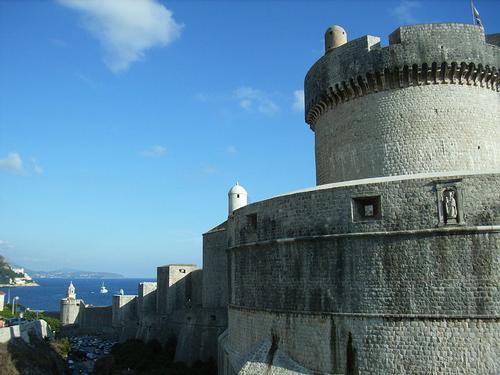 Dubrovnik Thick WallsPhoto: Mazbin CC 3.0 Unported no changes made
Dubrovnik Thick WallsPhoto: Mazbin CC 3.0 Unported no changes made
Travelers to Dubrovnik never have to wonder if there is plenty to see and do in this Croatian city. There are beautiful churches, monasteries, medieval sites, the remaining Renaissance heritage and many museums, not to mention the overwhelming city walls. Below is an overview of some of the most important sights.
The spectacular medieval walls, fortresses and gates of Dubrovnik's Old Town are its most overwhelming sight. The walls were built between the 13th century and the 16th century. The walls surround the old town and are between 25 meters and 82 meters high and from 6 meters to 20 meters thick and have literally protected the city for centuries. The views over the city and the sea are beautiful and there are four forts: St. John's Fort, the Revelin Fort, the Bokar Fort and the beautiful Fort Lovrijenac. A walk on the walls takes about an hour, longer if you take the time.
 Dubrovnic Palace of the RectorPhoto: Ardfern CC 3.0 (non transposée) no changes made
Dubrovnic Palace of the RectorPhoto: Ardfern CC 3.0 (non transposée) no changes made
The Rector's Palace is an ornate Venetian Gothic palace built on the south side of Luza Square where it replaced two previous palaces, both of which were demolished when stored gunpowder exploded in their cellars. The Rector's Palace dates back to the late 15th century and is known for its decorative facade, majestic staircase and atrium with the statue of the wealthy Croat Miho Pracat (1522-1607). Concerts held during the Summer Festival take place in the palace courtyard and always attract a large audience.
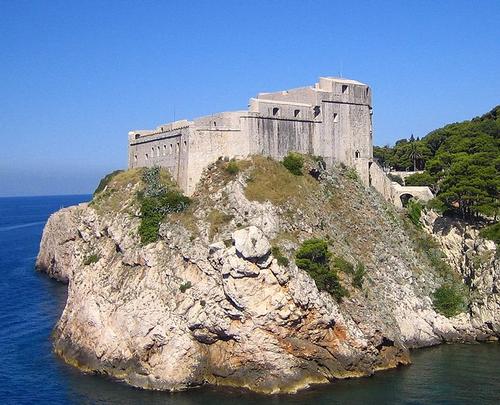 Dubrovnik Fort LovrijenacPhoto: Pufacz in the public domain
Dubrovnik Fort LovrijenacPhoto: Pufacz in the public domain
The construction of Fort Lovrijenac started in the 11th century. The fortress towers over the old town from its imposing position, atop a massive stone rock rising from the sea at the very tip of the peninsula. Two drawbridges lead to the interior of this prominent local landmark. The massive cannons liberated the city from the threat of the Venetian occupation between the 14th and 17th centuries; the 12 meter thick outer walls offered a lot of protection. Today there is a stage in the courtyard and the fortress is causing a furore as a Shakespeare theater.
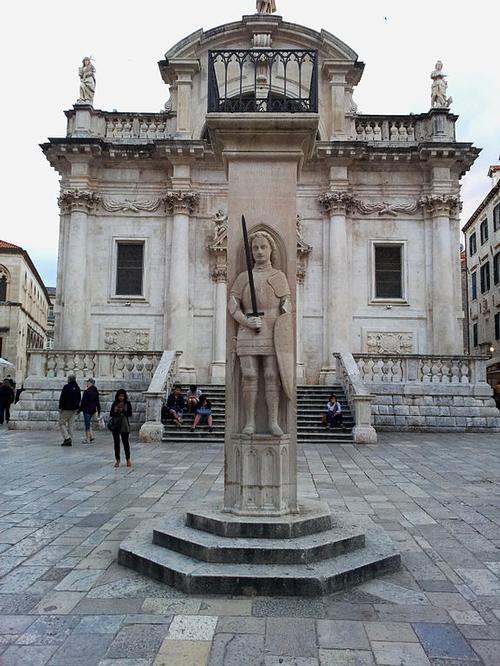 Dubrovnik Orlando ColumnPhoto: Bizutage CC 3.0 Unported no changes made
Dubrovnik Orlando ColumnPhoto: Bizutage CC 3.0 Unported no changes made
The Orlando Column is a chiseled stone statue of the legendary literary hero, 'Orlando Furioso'. Founded in 1419, the column was the place for public announcements, notices and punishments. Legend has it that the heroic warrior Ragusa defended the city against the Saracens in the 9th century. The Orlando column is often used as a meeting place and is a good reference point for tourists.
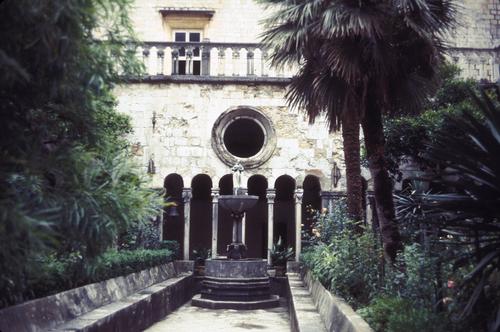 Dubrovnik Franciscan MonasteryPhoto: JERRYE AND ROY KLOTZ MD CC 3.0 Unported no changes made
Dubrovnik Franciscan MonasteryPhoto: JERRYE AND ROY KLOTZ MD CC 3.0 Unported no changes made
The Franciscan Museum Monastery is a 14th-century monastery that houses the third oldest working pharmacy in Europe. The pharmacy was built in 1317 and still sells herbs and lotions made according to the original recipes. The beautiful Romanesque cloister, the peaceful gardens, the 15th century well and the baroque St. Francis Church make a visit a must. Ceramics, old laboratory equipment, old medical books and recipes for timeless remedies are housed in the pharmacy. The Monastery Museum has gold and silver religious artifacts, embroidery, a famous library and many old paintings.
Tips
Dubrovnik's scenic Old Port is located right below the huge city walls and fortresses and you can see the red roofs of the old town. This is one of the oldest parts of the city and the harbor is full of private boats and shiny yachts as well as local fishing boats. The view of the harbor (from the sea to the city) is beautiful.
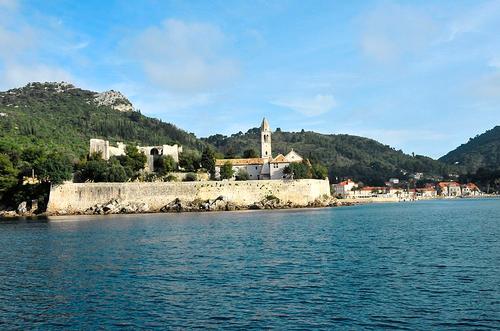 Croatia Lopud IslandPhoto: LBM 1948 CC 4.0 International no changes made
Croatia Lopud IslandPhoto: LBM 1948 CC 4.0 International no changes made
From Dubrovnik there are possibilities for day trips, the nearby Zaton Bay is ideal for day trips. Within easy reach of the city is the island of Mljet, with a lush national park that attracts many visitors. Only a relatively short distance away is the small island of Lopud, which belongs to the Elaphiti Islands archipelago. The island is famous for its beautiful sandy beaches, especially those around Sunj Bay.
Useful links Dubrovnik
BBC Country ProfilesWorld Fact Book Explore all Countries
How to call
Last updated June 2025
Copyright: Team - The World of Info